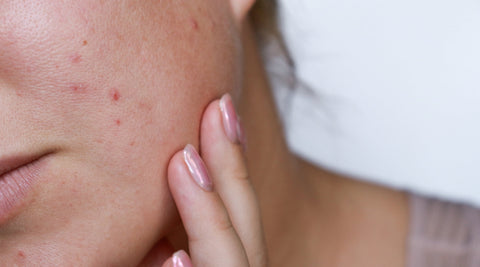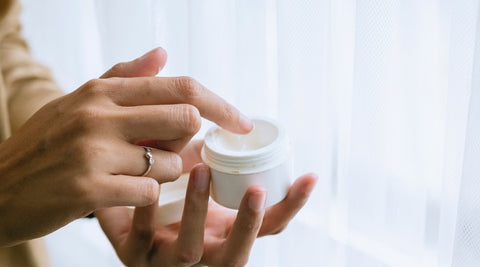You thought you’d outgrow it. So why are you breaking out now?
If you’re in your 30s (or 40s) and suddenly Googling “why am I breaking out again?”- you’re not alone.
Adult acne is rising rapidly, especially in women. Dermatologists are seeing more patients with stubborn breakouts well past puberty. But the causes aren’t as simple as “hormonal acne” or a few missed face washes.
In reality, adult acne is driven by a complex mix of inflammation, stress, lifestyle, environment, and yes, hormones. The good news? Once you understand the root, you can treat it more effectively.
First: What Counts as Adult Acne?
Adult acne refers to persistent or late-onset breakouts that happen after age 25, often showing up along the jawline, chin, cheeks, and neck. It can look like:
- Deep, painful cysts
- Whiteheads and blackheads
- Clusters of small red bumps
- Post-inflammatory hyperpigmentation (dark marks that linger long after a breakout fades)
Common Triggers of Adult Acne
1. Stress & Cortisol Spikes
Stress doesn’t just live in your head, it shows up on your skin. Elevated cortisol can:
- Increase oil production
- Worsen inflammation
- Impair skin barrier function
This creates the perfect storm for clogged pores and slower healing.
Sound familiar? That Monday breakout before your big presentation isn’t just a coincidence.
2. Barrier-Stripping Skincare
Ironically, many people with acne are using routines that make it worse.
Over-cleansing, exfoliating too often, and using high-strength acids or retinoids without breaks can strip the skin barrier. The result?
- Redness
- Increased sensitivity
- Breakouts that never quite go away
The fix: Simplify. Rebuild the barrier. Then introduce actives, one at a time.
3. Modern Life
Urban life is harsh on skin:
- Pollution increases oxidative stress and clogs pores
- Blue light (yes, from screens) may increase pigment and inflammation
- Poor sleep disrupts your skin’s natural repair cycle
If your breakouts correlate with long work hours, late nights, and screen fatigue, you’re not imagining things.
4. Diet
The research on diet and acne is nuanced. There’s no “acne food,” but some patterns can increase your risk:
- High-glycemic diets (white carbs, sugar, ultra-processed snacks) may increase insulin and sebum.
- Dairy has been associated with breakouts in some people, possibly due to hormones
- Low antioxidant intake can leave skin more prone to inflammation
Pro tip: Focus less on “cutting out” and more on crowding in: fiber, omega-3s, zinc, colorful produce.
5. Hormonal Fluctuations (Still a Key Piece)
Yes, hormones still play a role, especially around ovulation, pre-period, or with PCOS. But they don’t act alone.
Hormonal acne in adults tends to:
- Appear in cyclical patterns
- Show up along the lower face or neck
- Leave behind pigmentation or scarring
If your acne always shows up like clockwork before your period - or has gotten worse after stopping the pill, this could be a clue.
What’s the Best Way to Treat Adult Acne?
Here’s what works (and what doesn’t) based on current science and clinical practice:
What Helps:
- Barrier-first skincare (gentle cleanser, moisturizer, SPF)
- Topicals like azelaic acid or niacinamide
- Oral support: supplements like zinc with vitamin c, omega-3s, or spearmint extract
- Stress reduction (sleep, movement, breathwork, whatever works for you)
- Diet that supports blood sugar balance and reduces inflammation
What to Avoid:
- Harsh physical scrubs or aggressive facials
- Mixing too many actives at once
- Constant product switching
- Relying solely on “acne-prone skin” marketing terms without understanding ingredients
- Popping your zits
The Bottom Line
Adult acne isn’t a teenage problem with a new PR team. It’s a complex, inflammatory condition with roots in your lifestyle, environment, stress levels, and yes - your hormones.
But it’s also manageable. The key is understanding why it’s happening, so your treatment targets the root, not just the surface.
Because you deserve better than “just try another cleanser.”
References
- Tanghetti EA. (2013). The role of inflammation in the pathology of acne. J Clin Aesthet Dermatol, 6(9), 27–35.
- Zaenglein AL, et al. (2016). Guidelines of care for the management of acne vulgaris. J Am Acad Dermatol, 74(5), 945–973.e33. https://doi.org/10.1016/j.jaad.2015.12.037
- Dreno B, et al. (2015). Understanding innate immunity and inflammation in acne: Implications for management. J Eur Acad Dermatol Venereol, 29(Suppl 4), 3–11. https://doi.org/10.1111/jdv.13190
- Katta R, Desai SP. (2014). Diet and dermatology: The role of dietary intervention in skin disease. J Clin Aesthet Dermatol, 7(7), 46–51.
- Poli F, et al. (2011). Epidemiological study of acne in female adults: Results of a survey conducted in France. Ann Dermatol Venereol, 138(2), 121–125. https://doi.org/10.1016/j.annder.2010.10.019
- Zouboulis CC. (2014). Nutrition and acne. Clin Dermatol, 32(6), 765–772. https://doi.org/10.1016/j.clindermatol.2014.02.010



